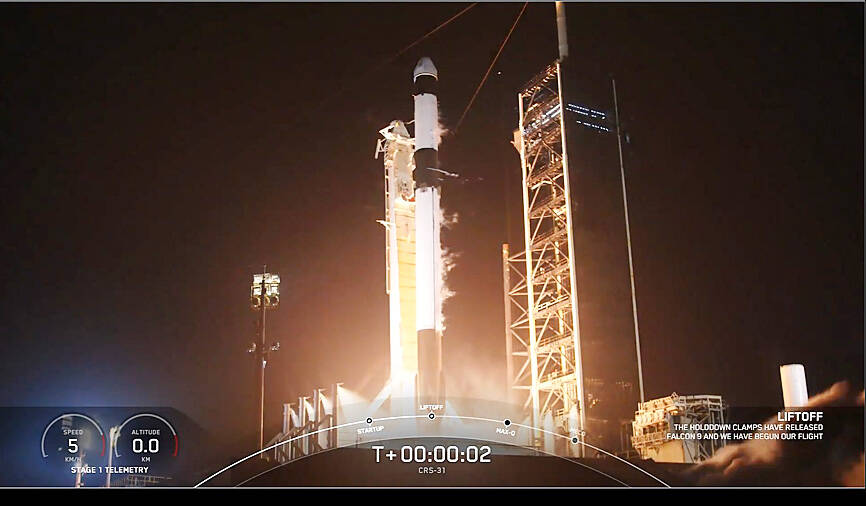Onglaisat, a satellite codeveloped by Taiwan and Japan, was successfully launched into space on Monday aboard a SpaceX Falcon 9 rocket, the Taiwan Space Agency (TASA) said yesterday.
The cube satellite, or cubesat, is scheduled to reach the International Space Station and be deployed into a 410km low Earth orbit in about one month to begin its test mission, the agency said in a statement.
During the six-month mission, Onglaisat would be used to validate the key technologies of a newly developed remote sensing system, said the agency, which is part of the National Science and Technology Council.

Photo courtesy of the Taiwan Space Agency
Onglaisat, which was launched aboard SpaceX’s CRS-31 resupply mission from Cape Canaveral, Florida, would test high-resolution data collection and image compression technologies it developed in collaboration with the Taiwan Semiconductor Research Institute, the agency said.
The small satellite would achieve a ground image resolution of 2.8m, surpassing the typical resolution of 5m to 6m for satellites of the same class, said Chan Chen-yu (詹鎮宇), the project’s leader.
The satellite, codeveloped by TASA and the Intelligent Space Systems Laboratory at the University of Tokyo’s Department of Aeronautics and Astronautics, along with several start-ups, also offers a valuable opportunity for scientific exchange and study, Chan said.
“Onglai” is a Hoklo (commonly known as Taiwanese) word that symbolizes aspirations for joint efforts between the two countries in space, he said.
The name means “prosperity” and “pineapple,” reflecting the launch, and hope for an enduring friendship and collaboration between Taiwan and Japan, he said.
The satellite was named in 2021, when Taiwan was seeking to expand its pineapple exports following a ban by China on the fruit from Taiwan, Chan said.
Japan showed strong support by purchasing large quantities, a gesture that resonated deeply with many Taiwanese, he added.

SHIPS, TRAINS AND AUTOMOBILES: The ministry has announced changes to varied transportation industries taking effect soon, with a number of effects for passengers Beginning next month, the post office is canceling signature upon delivery and written inquiry services for international registered small packets in accordance with the new policy of the Universal Postal Union, the Ministry of Transportation and Communications said yesterday. The new policy does not apply to packets that are to be delivered to China, the ministry said. Senders of international registered small packets would receive a NT$10 rebate on postage if the packets are sent from Jan. 1 to March 31, it added. The ministry said that three other policies are also scheduled to take effect next month. International cruise ship operators

HORROR STORIES: One victim recounted not realizing they had been stabbed and seeing people bleeding, while another recalled breaking down in tears after fleeing A man on Friday died after he tried to fight the knife-wielding suspect who went on a stabbing spree near two of Taipei’s busiest metro stations, Taipei Mayor Chiang Wan-an (蔣萬安) said. The 57-year-old man, identified by his family name, Yu (余), encountered the suspect at Exit M7 of Taipei Main Station and immediately tried to stop him, but was fatally wounded and later died, Chiang said, calling the incident “heartbreaking.” Yu’s family would receive at least NT$5 million (US$158,584) in compensation through the Taipei Rapid Transit Corp’s (TRTC) insurance coverage, he said after convening an emergency security response meeting yesterday morning. National

PLANNED: The suspect visited the crime scene before the killings, seeking information on how to access the roof, and had extensively researched a 2014 stabbing incident The suspect in a stabbing attack that killed three people and injured 11 in Taipei on Friday had planned the assault and set fires at other locations earlier in the day, law enforcement officials said yesterday. National Police Agency (NPA) Director-General Chang Jung-hsin (張榮興) said the suspect, a 27-year-old man named Chang Wen (張文), began the attacks at 3:40pm, first setting off smoke bombs on a road, damaging cars and motorbikes. Earlier, Chang Wen set fire to a rental room where he was staying on Gongyuan Road in Zhongzheng District (中正), Chang Jung-hsin said. The suspect later threw smoke grenades near two exits

The Forestry and Nature Conservation Agency yesterday launched a gift box to market honey “certified by a Formosan black bear” in appreciation of a beekeeper’s amicable interaction with a honey-thieving bear. Beekeeper Chih Ming-chen (池明鎮) in January inspected his bee farm in Hualien County’s Jhuosi Township (卓溪) and found that more than 20 beehives had been destroyed and many hives were eaten, with bear droppings and paw prints near the destroyed hives, the agency said. Chih returned to the farm to move the remaining beehives away that evening when he encountered a Formosan black bear only 20m away, the agency said. The bear